
Can I use an ‘indoor’ TV outside?
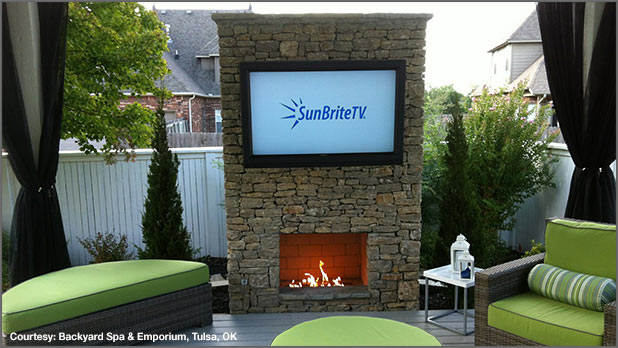 CNET reader Jason wants to know if he has to get a TV specifically rated to work outside, or if any TV will do. Geoff Morrison helps him out. CNET reader Jason wants to know if he has to get a TV specifically rated to work outside, or if any TV will do. Geoff Morrison helps him out.
CNET reader Jason asks:
“We have a covered porch that’s screaming for a television. I’m not worried about the “elements” as much as I am about the extreme heat and cold. Here in North Texas, we can see summer temps as high as 110 degrees and winter temps in the teens.
I know there are “weatherproof” televisions out there, but they are expensive. Is that my only route, or are there certain TVs that do better in the heat or cold of outside?”
Good question.
Outdoor televisions, from companies like SunBriteTV, are definitely expensive, often many times more expensive than a comparable-sized “indoor” TV ($1,495 for a 32-inch, for example).
The biggest issue with getting a TV to survive outside is not keeping out the moisture (relatively easy) or even protecting the delicate bits from the sun’s rays (same). The trick is getting the heat out.
All TVs are designed to work within a certain temperature range. Not coincidentally, this is about the same range you work best at as well. All generate heat, and thanks to years of development, most don’t need big fans to run well at room temperature.
Start pushing the edges of that temperature range, though, and bad things start to happen. In the cold, once the air warms up (like when night turns to day), water can condense and creating shockingly bad problems. The cold can also affect how the liquid crystal itself operates. In the heat, the lifespan of internal components drops precipitously.
So the trick with an outdoor TV is to seal it up against the elements, but at the same time allow the heat generated to escape. Usually this means extensive heatsinks, fans and a bespoke cabinet design. Many models have built-in heaters to maintain a specific operating temperature and other features to help them survive in the wilds of your back yard.
So it’s less the “elements” you have to worry about than the temperatures.
But let’s say you don’t want to spend $4,300 on a 46-inch TV.
(Before I proceed, let me be very clear and say that using an indoor TV outside is a fantastic way to void your warranty and shorten the life of your TV. It will break. Don’t say I didn’t warn you, and don’t blame me — or the lovely people who pay me — when your TV craps out).
Certain TVs are rated for a wider operating temperature than others. For example, I found multiple Panasonic models rated up to 95 degrees Fahrenheit (35C) and multiple Samsung and LG models rated up to 104F (40C). However, I still wouldn’t leave them outside. All are clear in their inability to handle condensation. Condensation will happen if you cover the TV or not.
You can find this temperature info either on the specs page on their Web sites, or by downloading the manual (it’s listed at the end).
My advice? Buy an outdoor TV; they’re built to do what you’re looking to do. They’re expensive for a reason. If you don’t want to heed that advice, get a TV that can withstand some heat, and put it on a dolly. Not remotely sexy, and it will require some extension cords, but where there’s a will, there’s a way. Get an LCD , as they’re brighter and generally do better in well-lit areas. Get something cheap, too, as it will probably break.
Take this TV outside only when you need it, and leave it inside when you don’t. Keep it out of the sun and maybe it will last longer than a season.
by Geoffrey Morrison
http://www.cnet.com/news/can-i-use-an-indoor-tv-outside/
Custom Installation Services, LLC – Authorized Sunbright TV Dealer in Charlotte, NC and surrounding areas
Posted in 3D TV, Apple, AppleTV, Audio Systems, Bose Dealer, Central Vac System, Curved LED TV, Flat Panel TV's, Home Theater Design, Home Theater Setup, iPad, iPhone, LED, lifestyle, Low Voltage Contractors, Media Rooms, Network Setup, News, OLED, Outdoor Speakers, Outdoor TV Installation, soundtouch, Sports Bar, Structured Wiring, Sunbright TV, technology
|
Time to Tune Up Your Home Theater?
Make your old system new again
Home theaters have been around for some time now. Sure, the screens have become bigger and the speakers more powerful. Throw in a media streamer or server, and the way a home theater looks and behaves today is a lot different than it did just five years ago. So, veteran owners of home theaters, is it time to update? Should you invest in new gear? Or, maybe there are some simple tweaks you can make that’ll have your home theater humming like it’s brand new.
We asked a few seasoned custom electronics professionals (CE pros) for their recommendations. Some of the suggestions you might be able to do yourself; for others you will probably need the help of a pro. Regardless, “A/V systems need maintenance just like anything else we use daily, like cars, HVAC systems and computers. There will always be maintenance needs and costs associated with your system,” says Jason Voorhees of Cantara Design, Costa Mesa, Calif., Many CE pros offer home theater tune-ups as part of maintenance package. Expect to spend between $125 to $300 for the service, which may include just a few updates or many, depending on the system specifics.
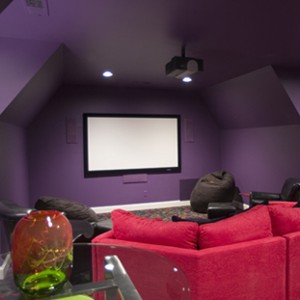
Dust off your equipment: Dust can cause home theater components to run at a higher operating temperature, potentially decreasing their lifespan. Any components that have accessible filters (projectors, media servers, PC, etc.), should be cleaned once a year.
Audio Tuning: If you originally tuned your system (or had a professional do it) right after taking your speakers out of their boxes, it’s almost a given that the elastic properties of your drivers have changed over time. As the drivers loosen up from use, the sound they produce can change. It is probably time to re-tune.
Settings: Assuming your home theater system is 1080p capable, make sure all of your devices are set to output at 1080p, include satellite and cable boxes, Apple TVs, etc.
Brightness: One thing that can decrease over time is the brightness of your video display, especially that of projectors. Every display has some built-in picture modes; these settings are often called Vivid, Dynamic, Movie, Standard, 3D, etc. You may find that by simply adjusting a picture mode that you suddenly have a better looking video display.
Update: If your system isn’t 1080p and HDMI, it should be. You’ll open your theater up to a world of high-def and streaming services.
Calibrate: refocus and recalibrate the projector; recalibrate the surround-sound system.
Firmware: Install and test new firmware updates for every part of your system. The updates may fix bugs or may make new features available.
Seats & Curtains: Clean and test all of the theater seating, and repair if necessary. If the theater has curtains, they should be cleaned also.
Batteries and Bulbs: If any components use rechargeable batteries (remote controls, power supplies, etc.), test them and replace if necessary. Replace dead light fixtures.
Clean the Screen: Use a tape-based lint roller on the black fabric frame (if you have a fixed screen). You’ll be amazed at how much dust this material attracts. For a fixed screen use a soft horse-hair brush to gently brush off the screen surface. If you have a roll-up screen, bugs like to fly into the roller and get embedded into the screen. Call the manufacturer to determine what kind of cleaning solution is best.
Test Tone: How do you know if a tweeter or a crossover is blown on one of your speakers if you don’t spend 20 minutes doing a simple test tone sweep on each speaker? Not sure if the tweeter is working? Put your hand over the tweeter and listen to the speaker. If the sound doesn’t change, you probably have a problem. Your listening tastes may change too, and by calibrating yearly for level, distance and speaker position (if your speakers are moveable), you’ll be able to tune-up according to your changing tastes.
Delete: Spend 10 minutes deleting channels you don’t watch from your DirecTV or cable TV on-screen guide.
Reboot: Reboot your DVR every 2 months. You might be surprised at how much faster it will operate.
New Additions: Many older home theaters have a set-top box, a DVD player and a local library of content on a media server, but may not have a streaming media player. It’s time to get an Apple TV, Roku or some other device that can stream content to your home theater. This might also involve reprogramming your remote and adding new cabling.
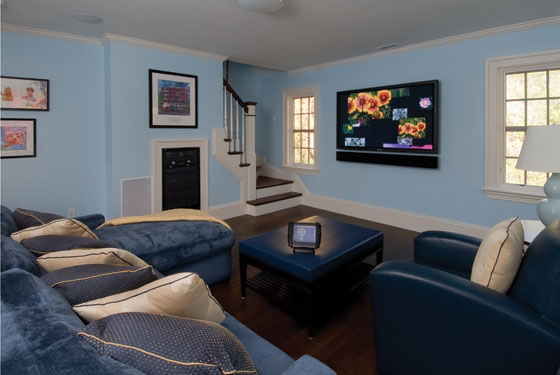
by Lisa Montgomery
http://www.electronichouse.com/article/time_to_tune_up_your_home_theater/D1/
Custom Installation Services, LLC – Your Home Theater Tune Up Specialists Charlotte, NC and surrounding areas
Posted in 3d movies, 3D TV, Audio Demos, Audio Systems, Automation, Blu-ray, Flat Panel TV's, Gaming Systems, HDMI Specs, Home Theater, i-Pad, IP Cameras, LED, Media Rooms, Multi Room A/V, Music and Movies, Outdoor Speakers, Panamax, Sports Bar, Structured Wiring, technology, Theater Seating
|
Anatomy of a Central Vacuum System: 5 Easy Pieces
What goes into a central vacuum system? We lay out the five basic pieces: power unit, piping, inlets, hoses and brushes and accessories.
Do you hate dirt and hate to vacuum? A central vacuum system may be just what you need. Instead of lugging a canister around the home, the heavy lifting is done by a power unit located some place like the garage, where it can barely be heard.
A central vacuum system can also be a healthier and greener choice, as it won’t emit dirt particles into the air, as do some other vacuum systems.
For consumers who are new to the category, we provide the foundations of a central vacuum system.
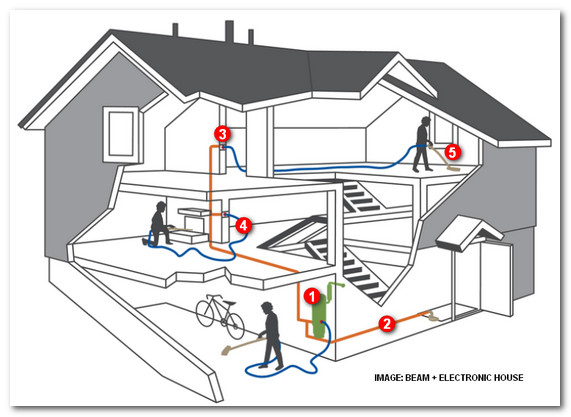
1. Power Unit
Drives the system and is usually mounted in the garage.
Bag vs. cyclonic (bagless) filtering: Bag-type systems require users to replace bags, but don’t require venting the system to the outdoors. Cyclonic units require no messy bags, but do need to be exhausted to the outdoors. Typical homes under 6,000 square feet can run off of a dedicated 20-amp, 120-volt circuit. Larger homes may require a larger, dedicated circuit. AirWatts typically indicate the power of the unit, but be cautious of using single high-air watt motors in larger home applications, as they may wear out too soon. Consider a unit with a utility valve on the tank for cleaning the cars and garage Typically code requires the wall between the garage and home to be penetrated with steel pipe. Check local building codes for safety requirements.
2. Piping
Provides suction from the power unit and delivers waste to the power unit.
2-inch special piping tested to specific standards. Cut the pipe with a miter box, chop saw, or tubing cutter. It must have a smooth, straight cut to reduce potential for debris getting stuck. Use wide sweeping turns at all locations after the inlet valve. For less friction loss, make jogs with 45-degree ells instead of 90-degree ells. Low-voltage wire follows along the outside of the pipe. Strap it to the pipe with zip ties or tape. Wire is run in series rather than home-run.
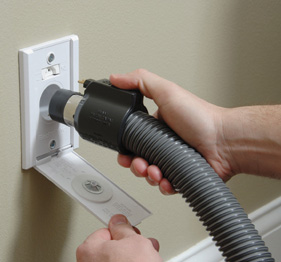
3. Inlets
Installed in the walls between piping and hoses.
Typically, one inlet covers 600 to 900 square feet of living space. Inlets are located at the same height as electrical outlets, but they can also fit in to the baseboards. Inlets are available as “air-only” or electrified. Electricity is required for traditional power brushes, but can still be provided with a separate cord for non-electrified (less expensive) outlets. Remember to place inlets near outdoor patios and porches. Plan for an inlet near the base of the stairs.
4. Hoses
Connect from the inlet to the vacuum cleaner.
Hoses normally come in 30-foot lengths, but 35-footers are available. Consider buying an additional hose and tool set for upstairs. A hose sock can protect baseboards and furniture. Designate a closet to hang the hose and tool set. Options are available for easy-to-tote spools and for hoses (up to 50 feet) that retract into walls.
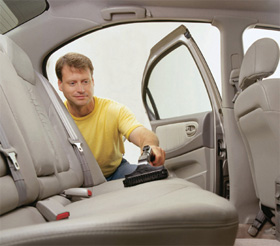
5. Power Brushes, Accessories
Connect to hoses for cleaning everything from carpeting to pets.
Power brushes are the best central vac accessory for cleaning carpets and other flooring. Most brushes require electricity, but some lower-powered units can operate via air power. Brushes come in a variety of shapes and sizes for cleaning upholstery, staircases, cars, underneath furniture and more. Additional accessories can be used for cleaning tight spaces, ceiling fans, pets and more.
Grant Olewire of MD Manufacturing contributed to this article.
By CE Pro Editors
http://www.cepro.com/article/anatomy_of_central_vac_systems/T320
Custom Installation Services, LLC – First choice for low voltage wiring and central vac in Charlotte, NC and surrounding areas
Posted in 3D TV, Automation, Central Vac System, Flat Panel TV's, Home Theater, IP Cameras, LED, lighting control, Low Voltage Contractors, Lutron Radio Ra II, Media Rooms, Outdoor Speakers, Structured Wiring, technology
|
Tagged 3d theater in charlotte, Best Buy, boone, business audio video, cable, central vac dealers in charlotte nc, charlotte audio advice, charlotte green electronics company, charlotte hd installers, Charlotte Home Theater, charlotte home theater installation, Charlotte onkyo dealers, comcast, commercial a/v installation charlotte, corporate a/v installation, custom home builders in lake norman, dirt devil, geek squad in charlotte nc, HD installers in Charlotte nc, home theater wiring, innovative systems, Lake Norman, Low voltage contractors, low voltage wiring, Lutron RadioRa2, marantz dealers lake norman, multiroom audio, network, satellite, speakercraft dealers in charlotte nc, sports bar a/v installers, sports bars, sunbrite, surround sound, time warner, tv installation, tv installers charlotte audio video installers, TV recycling, zobo
|
|
|
|
 CNET reader Jason wants to know if he has to get a TV specifically rated to work outside, or if any TV will do. Geoff Morrison helps him out.
CNET reader Jason wants to know if he has to get a TV specifically rated to work outside, or if any TV will do. Geoff Morrison helps him out.







